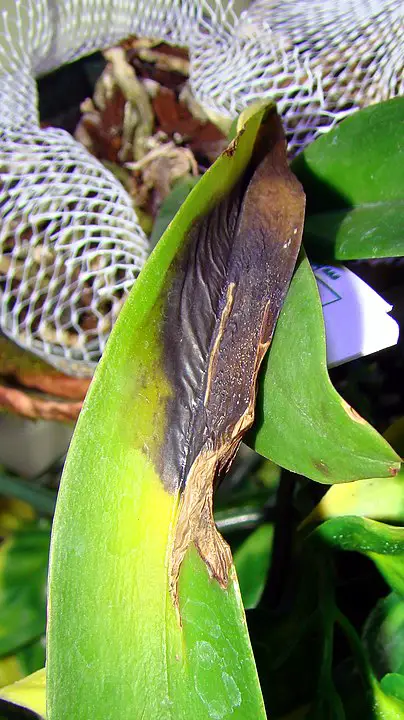I got a lot of emails asking me ” why my orchids leaves turning yellow”. It is a common problem for orchids growers. Actually orchids yellowing leaves can be caused due to different reasons. In this article, I will take you through the possible reasons why your orchids leaves turning yellow. And what to do about it.
Orchid leaves Turning Yellow As Natural stage of the growth cycle
Definitely this is the best-case scenario. As everything in this world goes through a normal life cycle, orchids leaves are no exception.
The plant discards its old leaves and shifts its energy and resources toward supporting new and young leaves.
Therefore it is possible that your orchids leaves are turning yellow because their existence as part of the orchids came to its end.
You know if that is the case by looking for the position of the yellowing leaves. If you found the yellowing leaves are on the lower part of the orchid crown.
And the new leaves ( the ones on the upper part) are light green and look healthy. This means your plant’s yellowing leaves is normal.
You don’t need to do anything about it except observing and enjoying the wonder of life itself.
That everything will decay one day. As all orchids leaves do. If you wish to cut them off before they naturally fall. Make sure to use sterilized scissors.
And only do so when the leaves turn to brown and they look completely dead. You don’t want to cut a living part as it became like an open wound. And it may make your orchids vulnerable to disease infection.
Root Rot May Turn The Orchids leaves to yellow
The most common reason for orchid’s yellowing leaves is root rot. The disease caused by fungi that already exist in the soil but in a dormant state.
Overwatering is what makes that fungus active and give them the perfect environment. Those fungi spread through the orchid root system and rot it.
They make it weak and unable to function well. Due to the inability of the orchid roots to absorb nutrients and oxygen the leaves start to yellowing and decay.
Orchids in its natural habitat live on other trees and use them as hosts. it absorbs moisture and nutrients through its roots from the air.
It doesn’t grow in soil in the rainforest. Therefore it is very sensitive to overwatering. And vulnerable to root rot.
The only way to know if your orchids suffering from root rot is to check its roots. You do so by removing the plant from its pot gently and inspect the roots.
The healthy roots look white. Altough some orchids have green roots. but in all cases the healthy roots will feel strong and firm.
While rotted root look brown or black and they feel mushy and soft.
Even they may fall while you checking them. If you found that the problem is root rot read my article about how to handle root rot the right way. It will guide you.
And remember let your orchid dry out between watering. The first inch of the topsoil should be dry before you water it. Plan your watering schedule accordingly.

Rotting and yellowing leaves of orchid Cattleya. By Pogrebnoj-Alexandroff – Own work, CC BY 3.0, https://commons.wikimedia.org/w/index.php?curid=22893360
Crown Or Stem Rot May Be The Cause of Orchid leaves turning yellow
Orchids in their natural habitat grow in trees edges in sloped angles. Or upside down.
When rain falls it give them moisture but the water will drain quickly. Most orchids growers grow their orchids grounded in the growing media.
Such a thing will make the crown exposed to water when you water the plant. Some water might be trapped between the orchid’s leaves. Such moisture can cause the crown and stem to rot.
To know if the cause of the orchids yellowing leaves is crown or\and stem rot look from where the yellowing begins.
If the yellowing starts from the heart of the plant toward the leaves tips it is a sign for crown and\or stem rot.
Also, grip your orchids from its pot to see the base of the crown. If you found it black, it is a sure sign that your orchid suffering from crown rot. The rotted stem will also look black.
Stem and/or crown rot is not easy to fix. The best practice is to discard the infected plant in order to prevent the disease from spreading to your other plants.
But if this specific orchid means to you more than just one of your plant collections. You may try to do your best to save it, and hope for the best.
In such a case put the infected plant in quarantine while you treating it.
You solve the problem by unpotting the plant and cutting off all the infected roots by using a sterilized pair of shears. And clean the roots from any soil.
Then spray the whole orchid with Hydrogen Peroxide 3%. And let the plant air dry for moments.
Then apply ground cinnamon to the affected area ( crown and\or stem). The cinnamon is a natural fungicide that creates a dry environment. Which is something bad for the fungi that caused the rot.
It keeps the rot from spreading. After you did so, repot your plant in new potting media. Make sure when you repotting the affected area is reasonably far from the potting media.
You want the affected area to stay dry in order to recover. And if it in direct contact with the potting media it will get wet. definitely this will not help in the recovery.
Your Orchid Leaves May Turn Yellow Because Sunburn
Orchids are native to rainforest, they grow in the rainforest canopy layer. where there is only indirect sunlight.
Therefore it only needs indirect sunlight to survive. Their exposure to direct sunlight may cause their leaves to turn to yellow.
If you want your houseplants to thrive create environment and conditions similar to their natural habitat as much as you can.
The leaves that sunburned will have patches and sometimes dots and they will look more faded out.
To make sure that sunburn is what made your orchid’s leaves turn to yellow, look to the orchid location.
If the plant located in a spot exposed to direct sunlight like windowsill and especially in the summertime.
This means your plant most probably suffering from sunburn. In such a case move your orchids to a new spot that gets bright but indirect sunlight.
If you live in a place where it gets too cold in winter, you can move your plant to the southwest windowsill to get enough indirect sunlight.
But remember to place it in a more shaded spot during summer. When temperatures rise and the sunlight intensity increase.
The yellow leaves that caused by sunburn will not turn green again. Instead, they will fade away and drop naturally.
Your job is to save the healthy leaves and the new growth by moving the plant to a more suitable spot.
Low Temperature Can Turn Orchids Leaves To Yellow
As much as direct sunlight can cause your orchids leaves to turn yellow, the low temperature has the same effect.
As I mentioned before orchids are native to rainforests. Which means they survive and thrive in a warm and humid atmosphere.
If your plant exposed to cold (under 60 Fahrenheit degree). Then most probably the yellowing leaves caused by the low temperature.
If this is the case, set the room thermostat between 70 and 80F and your plant will recover.
Lack Of Nutrition
You may think that the nutrients found in the growing medium are enough to feed your orchid.
While it is to some extent true. it is true in the beginning but when time goes on. Your plants consume the soil nutrients. And it will need you to give it some nutrients.
The yellowing of orchids leaves can indicate a nutritional deficiency. Nitrogen and magnesium help the plant to produce chlorophyll, which is the substance that gives the leaves the green color.
When there is a lack of one or both of those two elements the discoloration happens.
And orchid leaves start to yellowing. The lack of iron may also cause your plant’s leaves to turn to yellow.
But the difference between leaves yellowing due to the lack of iron or other elements is in case of iron deficiency, the yellowing will start from the young leaves and then go through the old ones.
On the other hand, other elements deficiency will start on the older leaves and then will proceed to the younger ones.
To know if the yellowing on your orchids leaves caused by nutritional deficiencies or other causes look for the yellowing spot on the leaf.
If the yellowing occurs on the sides of the leaves most probably it happens because of the lake of nutrients.
Also, recall when the last time you fed your orchids. If it too long or you didn’t before. Treat your plant by giving it the right type and amount of fertilizer.
Pests Infestation
Another possible reason for your orchids leaves turning yellow might be a pest problem.
The plant at the beginning of the infestation will look normal. It will not show signs just like the case of root rot.
The yellowing leaves only happen after the infection in its advance level. usually at such a level, it is hard to defeat it.
And the safe action to take is to discard the orchid. In order to save your other houseplants from infection.
But if you decide to fight those crepy little creatures, I got your back. inspect the orchid to know if the problem is pests infection or something else.
you do so by looking to the yellowing leaves. See if there are little marks on the leaves like webbing and/or live insects.
Some insects are two little to be seen by a naked eye. Therefore use a magnifying glass.
Another factor to look for in order to know if it is pests problem is to look to the overall plant strength.
The pest’s infection makes the growth very hard. And it may hinder the blooming. And even if there are blooms. The flowers may look deformed.
If that is the case it means your orchid is suffering from pests problem. Put the orchid in quarantine immediately, while you working in the solution.
Dip a toothbrush in detergent that contains 70% alcohol. Then scrub all the leaves including the bumps and crevices.
After you did so, spray the hole orchid with horticulture oil.
Conclusion
Through this article, I hope I answered the question: Why my orchids leaves turning yellow?!
And remember Orchids yellowing leaves is a symptom that can be caused by different factors.
In order for you to fix the problem, you need to know the real cause and act fast.
The sooner the better.
